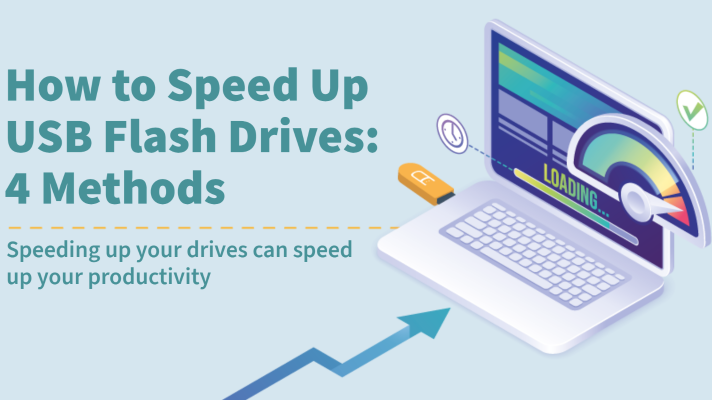
How to Speed Up USB Flash Drives: 4 Methods

USB drives are known to be one of the best types of portable storage devices ever invented. Millions of people like you use them daily to hold information and transfer data from one device to another. Many manufacturers advertise the data transfer rate of their USB drives as a way to entice you into choosing their brand. It is not uncommon to find that the data transfer rate of your USB drive has slowed down considerably from the advertised rate over time.
Slower data transfer rates make the transfer process take longer, which can be very frustrating if you are trying to get things done quickly. Fortunately, there are a variety of methods you can use to increase the data transfer speeds of your USB drives. Here are several different things that could be affecting the data transfer rate of your USB drives and how to speed up USB data transfer rates in each case.
CTA: Check Out Our New USB C Memory Stick
1. Temporarily Disable Security Options
In some cases, the data transfer speed of your USB drive is being affected by the security you have running on your device. Windows Security and other real-time protection options can detect an improperly configured or malware-exposed USB drive as a threat and actively slow or stop the transfer of data. Problems with your operating system can also result in slower data transfer speeds. This is likely to happen when a new USB drive is linked to the device for the first time.
The easiest way to solve this problem is to temporarily turn off the device's security features while performing the data transfer. Turning off the security features should only be done if you are confident that the device and the USB drive you are using have not been compromised. If you have disabled the security features and rebooted your device and the transfer rate is still slow, something else could be affecting the process.
2. See if the USB Drivers Need Updating
Outdated settings for your USB drivers can also affect the data transfer speed of your USB drives. Updating these drivers can restore the USB drive's transfer rate by fixing these settings and any corruptions the driver has been exposed to. In some cases, you will need to reinstall the USB driver to reset the system settings that are affecting your USB drive.

3. Make Sure the Port and the Drive Have Identical Data Transfer Rates
Many of the newer devices you can buy today are built with a USB 3.0 port, so using a USB 3.0 drive will give you the best data transfer rate between the drive and the device. If you are plugging a USB 3.0 drive into a USB 2.0 port, your maximum data transfer rate will be capped at the rate the port can handle. Upgrading to a newer version will give you a significant increase in the data transfer rate. USB 3.0 transfers data at 4.8 Gbps while USB 2.0 has a data transfer rate of 480 Mbps.
4. Change the Type of USB Drives You're Using
Different types of USB drives have different data transfer rates and the older the flash drive is, the slower it will be at transferring information from newer computers and devices. There is also an issue if the connecting port of the USB drive has been compromised as that can also slow down the data transfer rate considerably. In these cases, your best option is to purchase new USB drives for holding your digital data.
Take a Look at Our Wide Selection of Bulk Flash Drives
Before taking the leap to buy new USB drives, there are some things you should keep in mind. Has the USB port you are using become worn over time? Are the programs on your device compatible with the USB drives you intend to use? Are the performance settings of your device affecting the maximum data transfer rate? Any of these things can be factors in the slow rate of transferring data.

Get the Best Performance Out of Your USB Drives
Ensure you are using your USB drives to their fullest potential by fixing the issues that could be leading to a slower data transfer rate. We carry many different types of USB drives so you can find ones that are right for your current situation. Contact us today to see how our USB solutions can help you learn how to speed up USB data transfer rates and be more efficient.